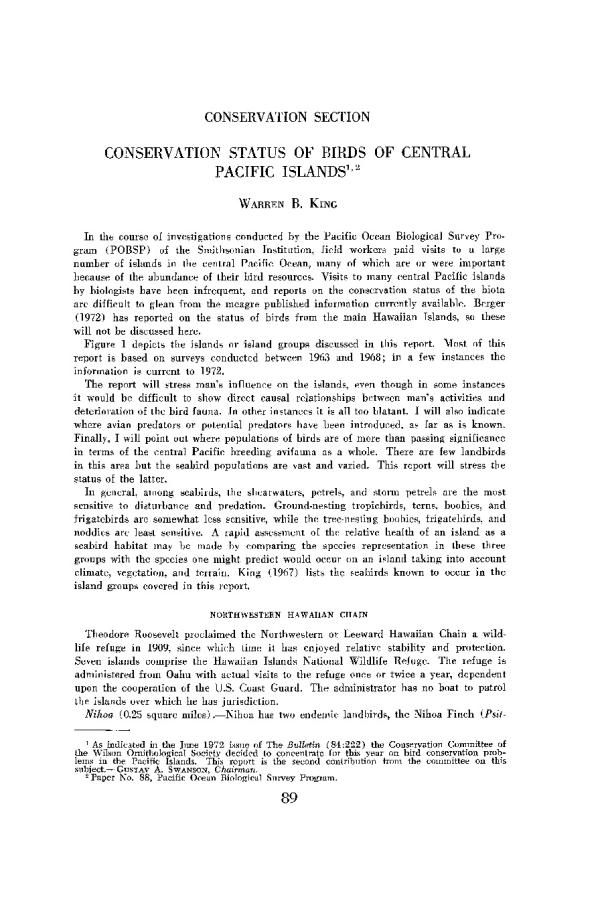Location
ACIS
Publisher
Pacific Ocean Survey Program
Publication Year:
1973
Publication Place
USA
Physical Description:
[7 p.] ; 29 cm
Call Number
VF 2772
Relevant Countries
Pacific Region
Language
English
Record ID:
839
Legacy PEIN ID:
50652
General Notes
Article kept at Greg's collection|Invasive Species Vertebrates Literature Review|Article kept at Greg's collection
Available online
Abstract
In the course of investigations conducted by the Pacific Ocean Biological Survey Program (POBSP) of the Smithsonian Institution, field workers paid visits to a large number of islands in the central Pacific Ocean, many of which are or were important because of the abundance of their bird resources. Visits to many central Pacific islands by biologists have been infrequent, and reports on the conservation status of the biota are difficult to glean from the meagre published information currently available. Berger (1972) has reported on the status of birds from the main Hawaiian Islands, so these will not be discussed here. Figure 1 depicts the islands or island groups discussed in this report. Most of this report is based on surveys conducted between 1963 and 1968; in a few instances the information is current to 1972. The report will stress man’s influence on the islands, even though in some instances it would be difficult to show direct causal relationships between man’s activities and deterioration of the bird fauna. In other instances it is all too blatant. I will also indicate where avian predators or potential predators have been introduced, as far as is known. Finally, I will point out where populations of birds are of more than passing significance in terms of the central Pacific breeding avifauna as a whole. There are few landbirds in this area but the seabird populations are vast and varied. This report will stress the status of the latter. In general, among seabirds, the shearwaters, petrels, and storm petrels are the most sensitive to disturbance and predation. Ground-nesting tropicbirds, terns, boobies, and frigatebirds are somewhat less sensitive, while the tree-nesting boobies, frigatebirds, and noddies are least sensitive. A rapid assessment of the relative health of an island as a seabird habitat may be made by comparing the species representation in these three groups with the species one might predict would occur on an island taking into account climate, vegetation, and terrain. King (1967) lists the seabirds known to occur in the island groups covered in this report.
Location
ACIS
Publisher
Pacific Ocean Survey Program
Publication Year:
1973
Publication Place
USA
Physical Description:
[7 p.] ; 29 cm
Call Number
VF 2772
Relevant Countries
Pacific Region
Language
English
Record ID:
839
Legacy PEIN ID:
50652
General Notes
Article kept at Greg's collection|Invasive Species Vertebrates Literature Review|Article kept at Greg's collection
Record Created: 01-Mar-2000
Record Modified: 23-Mar-2022

